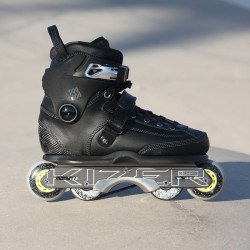Frames
439 itemsThe frame is definitely the most important piece of a skate next to the boot. After all, they define how the skates ride and what you can do in them. There are many frame types – almost every skating style uses different frames. Furthermore, the materials used to make frames vary. The most popular is aluminium, however it can be processed in several ways and frame can be extruded, casted, CNC machined of pressed from thick sheet. There are also composite frames, or as some people say, plastic ones – the ones sold separately are used mostly in aggressive inline skating. There are even super rigid and lightweight carbon frames.
If we were to cover the subject of frames in-depth, it would take several pages. Thus, we will describe only the most important differentiating factor: the mounting standards:
165 mm mounting – frames using this standard are most widely used in freeskating and freestyle slalom. Sometimes this standard is used also in junior speedskates. The front mounting point is placed approximately 1 cm below the rear one (raised heel) and their spacing is 165 mm. It is worth to note that placement of mounting points in relation to the foot is not unified across manufacturers. Thus, a frame made by one company can be placed too far to the front or back under boot made by another company. More advanced skates get around this problem by giving an option to adjust frame position under the boot.
195 mm mounting – most widely used in speedskates, less common in fitness skates. Just like in case of 165 mm mounting, the front mounting point is placed approximately 1 cm below the rear one (raised heel), but the spacing is 195 mm. This standard was first used by Fila to get around technical limitations of shorter spacing, which made 4x100 mm frames very high due to front bolt being directly above second wheel. It is worth to note that some frames are compatible with both 165 mm and 195 mm spacings.
UFS (Universal Frame System) – standard developed by several companies at the beginning of the century. It is intended for aggressive inline skating and as of now, it is the default one for such skates. The mounting points are placed 165 mm apart, but are on the same level. Furthermore, the holes for screws have nubs around them, which go in the cavities in the frame. This makes the connection more secure and lessens the strain put on the bolts while doing tricks, especially topside grinds. All UFS frames are compatible with all UFS boots. Apart from use in aggressive skating frames, UFS freeskating frames also do exist.
Trinity mounting – designed by Powerslide and found only in their skates. This is a modification of 165 mm frame mounting – instead single bolt at the front, in line with wheels, there are two bolts placed on the sides. Together with mounting point under the heel, they form a triangle. Thanks to it, the distance of the foot from wheels can be lower no matter the wheel setup, giving lower centre of gravity. The frame rigidity is also increased, resulting in superior power transfer. In addition, the vibration while skating is distributed more evenly, resulting in more pleasant skating experience. Trinity can be used in skates of all types, apart from aggressive ones. All Trinity frames fit all Trinity boots – you can swap and combine them sa you wish. Nothing stands in the way of attaching a speedskating frame to freeskating boot, for example.
Sizes: M - XL
Powerslide - Trident Ice Blade Ice Skates
Sizes: XXS/XS - L/XL
Powerslide Iceblade Sabres 3 Inline Skate Frames
Powerslide - Next Outback 150 Set Inline Skate Frames
Powerslide - Next Edge 150 Set Inline Skate Frames
FR - Ice Freestyle Frames - 316mm - Black Inline Skate Frames
Powerslide - SUV 165mm - Ready To Roll Inline Skate Frames
Powerslide - Elite Casted 4W 4x90mm - 275mm - Black Inline Skate Frames
Kizer Level 3.1 X Hyper Bullzeye - Complete Inline Skate Frames
Sizes: S - L




























































































